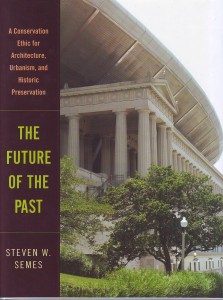
How should contemporary additions to historic structures or new buildings in historic districts relate to the existing character of the neighborhood? Noted expert and author Steven W. Semes discusses the challenges faced by review boards, architects and designers, and the difficulties inherent in following sometimes confusing historic standards and guidelines on March 5th, 5:30-7 pm, at the Virginia Center for Architecture, 2501 Monument Ave.
Increasing public concern has arisen over new buildings and additions to old buildings that are conspicuously in contrast with their surroundings. Such projects are often justified by an interpretation of the Secretary of the Interior’s Standards for Rehabilitation (the de facto national preservation policy written and administered by the National Park Service) that places greater weight on “differentiation” than on “compatibility”—the two requirements for new construction in historic settings specified in the Standards. This interpretation has led architects and historic district commissions to adopt contrasting styles of architecture to satisfy the “differentiation” requirement, though the Standards do not mandate any stylistic approach. In many instances, architects designing in traditional styles have encountered resistance from preservation authorities when proposing stylistically sympathetic designs in historic settings.
In his book, The Future of the Past: A Conservation Ethic for Architecture, Urban Design and Historic Preservation (W. W. Norton & Co., 2009), Semes reflects on the emergence of new traditional design practice among contemporary architects and urban designers and the issues this raises in the preservation field. He makes a persuasive case that context matters and that new buildings and additions to old buildings should be visually harmonious with their neighbors.
A practicing architect for more than 30 years, Semes has designed a variety of projects for preservation and new construction throughout the United States. In addition to many articles, Semes is also the author of The Architecture of the Classical Interior (2004) and a contributor to “The Elements of Classical Architecture” (2001), also published by W. W. Norton & Co. An Associate Professor at the University of Notre Dame School of Architecture, Semes was Academic Director of the Notre Dame Rome Studies Program From 2008 to 2011. He is a fellow emeritus of the Institute of Classical Architecture & Classical America (ICA&CA) and was educated at the University of Virginia and Columbia University. He is also the recipient of the 2010 Clem Labine Award for contributions to a humane built environment.
Semes’s presentation is free and open to the public. A reception and book signing will follow. Because space is limited, reservations are required. Please contact Andy Liguori, at aliguori@aiava.org or (804) 644-3041, extension 100 for reservations. Sponsored by Old House Authority and Fan District Association.
